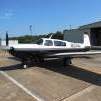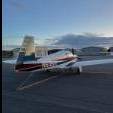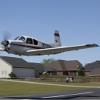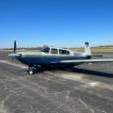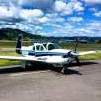All Activity
- Past hour
-
To my best knowledge I was told to keep CHT's low 380's to keep the engine happy even if you have to crack the cowl flaps open a little. Speed loss when they are half open is probably 1-2kts. Gas is less expensive than cylinders or premature turbo overhaul. Last time I was up at 17k TAS was 180kt at 17.7 GPH with hottest cylinder at 383 and TIT 1595. I am planning to install fine wire plugs during next annual and have my injectors recalibrated by gammi. Hopefully it will have a more complete burn and reduce TIT. Engine is around 270 since factory reman and I am trying to last as long as possible without any major service. Time delta on a 500nm flight and running it hard to get additional 10kt is 9 minutes.
-
I have an annunciator panel in my junk pile. Send me a pic and/or part number and I will see if it will work for you.
-
I have a g500txi with Garmin eis and no vacuum pump, so I think I have everything covered except gear.
-
I did the same thing and removed the annunciator. You’ll need engine monitoring to substitute for the fuel low and voltage lights not to mention the engine instruments, get rid of the vacuum pump, and then it’s just gear lights. Be aware the nav lights dimming circuit for gear down light.
-
I'm pretty sure that's who I contacted, it's $250 to bench test it and that's waved if I accept the repairs, but honestly I just don't want the downtime to deal with this thing more than I have to because I don't have a good mechanic at my field atm, that's why I was wondering if there was just something dead simple I could replace it with to avoid any future issues with it. Does anyone know if it's necessary for flight? Can I pull it out and rely on the floor indicator while it's being serviced -- I don't like that idea, just curious.
- Today
-
Ya I think I only see any reading on my CO monitor when I'm on the ground with the door open, and that I think maxes out around 5-8.
-
Hi @GBFlyer, I am based in Madison, but frequently go to 3D2, Ephraim. I would be happy to let you know when I go there next time (probably in about two weeks). If you want to come over there I am happy to take you up for a ride, or we could arrange for me to meet you at KGRB on my way there or back. My plane is an E model. Let me know if you're interested (you can DM me), and we can try to arrange something. Andrei.
-
Sell my E as is or overhaul engine then sell
TheAv8r replied to Spurious Moppet's topic in Vintage Mooneys (pre-J models)
Do you have an engine monitor? That could bring some peace of mind too so the narrative to new buyers is: OHed by Zephyr, a well-known shop Everything done by the book, accessories replaced, hoses, etc., all well documented in the logs Here are the instructions from Zephyr and Lycoming for break-in, here is the engine data from the first 5/10 hours showing how the break-in was completed, power settings, CHTs, etc. Here is the oil analysis from the first 2 oil changes following break-in showing a reduction in wear metals -
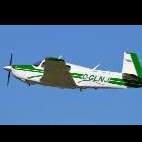
Sell my E as is or overhaul engine then sell
Slick Nick replied to Spurious Moppet's topic in Vintage Mooneys (pre-J models)
I'd still prefer to have it done myself. The first 3 hours on a new engine are the most important in determining the engine's health moving forward. If I was the one putting those hours on, I'd feel much better about everything from then on out. -
Very nice
-

Open Door In Flight training?
Pinecone replied to wombat's topic in Mooney Safety & Accident Discussion
If the plane is not controllable, then nothing you can do will change the outcome. My point is, to have pilots experience window or door opening to 1) show them it is not a big deal and 2) to teach them to ignore the distraction and FLY THE AIRPLANE. -

Sell my E as is or overhaul engine then sell
Pinecone replied to Spurious Moppet's topic in Vintage Mooneys (pre-J models)
I agree that in general, needing and overhaul is better than just overhauled. BUT, the shop that did the overhaul can flip that. A quality shop overhaul would be a good thing to me. A no name shop or known marginal shop would be a NO GO. -

Repair/Replacement Options for the Electric Cowl Flaps Motor
Pinecone replied to JohnM's topic in Modern Mooney Discussion
You didn't have to give details. -
That’s not “normal”. Even though OSHA standards say that in a work environment so many PPM of CO is acceptable I wouldn’t accept any in the airplane except in taxi with the door ajar and the side window open. Adding fresh air to dilute it is just masking the leak. If you are getting any in climb or cruise it is getting in through a leak somehow. Two questions would be: Where is it coming from? How is it getting in? Usually if everything is good in the engine compartment it gets in through the cabin door seal or if there are screws or camlocks missing on the belly. But if there’s a leak in the engine compartment it could also be coming in through the firewall. This is something I would chase down in case it’s.the exhaust system showing signs of wearing through. I had a the back side of a tailpipe joint coming apart on a Bravo which was not picked up on a visual inspection but was discovered with a CO detector.
-
takair started following M20F Down Lock Block
-
I think @Alan Fox had one a while back?
-
Ok any idea where to find those drawings? Sent from my iPhone using Tapatalk
-
You might want to replace both blocks while you're at it, the Up and Down blocks. Someone posted the drawing a couple of years ago, which would let yiu go OPP and hire someone to make a set for you.
-
I did mine by myself. The headliner needs to drop down in one piece. Once the tubes and wiring are disconnected, you can remove the three screws holding the two halves together and remove the headliner in two pieces. That’s the only way to get it through the door. You can see in one of my photos where I reinforced the nuts for those three screws with cement.
-
JBlueSkys started following M20F Down Lock Block
-
No, they’re on back order. Sent from my iPhone using Tapatalk
-
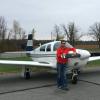
Annunciator lights in a 79 m20j
blaine beaven replied to Thedude's topic in Modern Mooney Discussion
That was actually the reason for the photo, because my CO Warn light (the bottom in the row) was not on despite the CO detector beeping. This was in the climb. It will creep up like if I don’t have fresh air coming in. As soon as I get into cruise and close the cowl flaps it drops to >5ppm. Thats just a trick of the light, it was not illuminated. That light is a voltage annunciator. -
A quick look at the Speed Power vs Altitude chart in the POH says to get 200KTAS it would take 34/2400 @ PeakTIT of 17.6 GPH to get near those speeds. Really, you are looking at more like 20.5-21gph to do it, well more properly. I didn't include it above, but I did run 34/2400 cruise for a 5-10 minutes after level off. At 10k and +9c I was at a temp adjusted 20.8 FF for the Power FF on the chart, 1620TIT, 408CHT with the Cowl Flaps closed. The TIT is the absolute limit it's been suggested I tolerate to keep the exhaust from failing over time, and the CHT is 9 degrees over my personal max. POH calculates 187KTAS for that setting, I was getting 185KTAS at close to MTOW. It will do it, but not interested in living at that power setting in cruise. I'll get the numbers you suggest at 18k & a 31/2200 power setting for that FF. HTH
-
I guess I am in the ball park. My TAS is 180+- at those altitudes on 17-18 GPH at full gross. Little better when light. I was just looking at some of the other Bravos and they state that at that altitude should be at 200kt + with TKS.
-
I got the front and back out by myself; I think you could re-install by yourself but I'll get another set of hand to make it easier/lessen risk to making mark on the new paint.
-
Got it, thanks! Looks like a two person job to get that down while holding it up and having enough arms left to disconnect vents and wires!
-
Went flew to lunch last Saturday at Port Townsend, WA (0S9) and one flew in. Older gentleman having lunch also.

